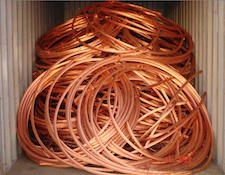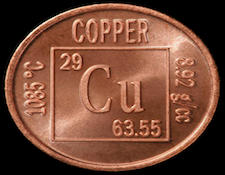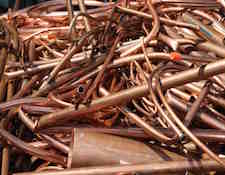It’s the time of year for saving money!
In the last installment of this continuing series about the materials that our High End audio toys and goodies are made of, I wrote about ultra-pure copper. That’s the stuff that (as everybody knows by now and some in the audiophile community continue to attack) is often used for premium cables and (as either the audiophile community DOESN’T know or the doubters are somehow willing to make an exception for) in the manufacture of, among other things, the very latest large scale integrated circuits.
 In these applications and others, copper of extreme purity (99.999% or better) is claimed to offer significant performance advantages – including making our stuff actually sound better — and after describing what it is and how it’s rated, both percentage-wise and by the number of “9”s or “N”s in its description, I went on to tell, among other things, how it’s made (usually by a process akin to “zone refining”) and to look what it is about ultra-pure metal conductors that might be the cause for whatever improvement they might bring.
In these applications and others, copper of extreme purity (99.999% or better) is claimed to offer significant performance advantages – including making our stuff actually sound better — and after describing what it is and how it’s rated, both percentage-wise and by the number of “9”s or “N”s in its description, I went on to tell, among other things, how it’s made (usually by a process akin to “zone refining”) and to look what it is about ultra-pure metal conductors that might be the cause for whatever improvement they might bring.
In doing that, I considered, once again, two of the more commonly claimed causes for conductors of different metals to impose different sonic characteristic on the signals that pass through them. The first of those is crystal distortion (or even breakage) in the process of rolling or drawing metal down to a desired thickness (AWG gauge), which is said to affect the conductor’s overall ability to pass signal. The second is the presence of oxide “micro-diodes” at the junctures between the crystals of the conductive metal, which its believers claim gives wire a directional “bias” and affects its ability to pass very low-level alternating current (music) signal information. Of these two, the first is simply a fact of the normal wire manufacturing process, and, in strong support of the second are the additional facts that certain oxides of both copper and silver are known to be semi-conductive when present as thin films, and that such films or their equivalents have been proven to exist between the crystals of all kinds of metal conductors, including those used for High End audio.
Perhaps the most important fact that I found for understanding the effect of ultra-pure metals on the conductors made from them is that “zone-refining” and similar or related technologies used for making very high purity metals are “continuous casting” processes and produce wire that may never be subject to the distorting or breaking forces present in more conventional wire manufacture. That, just in itself, seems ― at least for ultra-high purity metals ― to either greatly lessen or even remove entirely the first claimed possible cause for a distinctive sonic signature. And, although I frankly have no idea how they could measure it, at least one manufacturer of ultra-high purity copper claims that, with continuous casting and its ability to “grow” crystals to whatever size may be required , instead of the roughly 400 crystals PER FOOT said to be typical of more conventionally produced copper wire, the average single crystal length in their products is 125 meters (410.105 feet). If that’s true, it means their crystals are more than 164,000 times as long as the crystals in “ordinary” copper, and have, therefore, 164, 000 times FEWER crystal junctures for micro-diodes to form at. This should at least greatly reduce the possibility diode-related signal loss or modification and, with the lack of other crystal-related problems, make it possible that whatever improvement ultra-pure metals bring to our High End audio products is not the result of the greater purity at all, but simply a side-effect of the lessened crystal count.
 As trolls, unbelievers, and even some very well-educated and well-meaning other people keep reminding me, however, broken copper crystals WILL grow back together under certain circumstances and the effect of micro-diodes has never (at least to my knowledge) been formally proven by measurement or strictly administered double-blind testing. In short, it might all be exactly the voodoo and uninformed conjecture that its doubters make it out to be,
As trolls, unbelievers, and even some very well-educated and well-meaning other people keep reminding me, however, broken copper crystals WILL grow back together under certain circumstances and the effect of micro-diodes has never (at least to my knowledge) been formally proven by measurement or strictly administered double-blind testing. In short, it might all be exactly the voodoo and uninformed conjecture that its doubters make it out to be,
One thing, though, that IS certain is that a thin film of copper oxide (either cupric- or cuprous-) DOES act as a semiconductor (in its simplest form, a diode) Another fact is that EVERY SINGLE PIECE OF UNPROTECTED COPPER THAT HAS EVER, FOR ANY PERIOD OF TIME, BEEN EXPOSED TO THE ATMOSPHERE IS COVERED WITH A THIN FILM OF COPPER OXIDE AT EVERY POINT THAT MADE CONTACT WITH THE AIR. That means that virtually every piece of seemingly bare copper that we have ever touched or used for any purpose at all is actually covered with a copper oxide semiconductor layer – a diode. One final fact is that two diodes form the basis for a simple rectifier (If you’re not an E.E., ASK one; he’ll tell you it’s true) that can ― under the right circumstances and if the electrons of your music signal truly behave as some people claim they do ― turn portions of the AC signal of your music into DC and rectify some of the detail of what you want to listen to right out of existence.
It all has to do with wire, and, stated most simply, there are really only three kinds of wire: Single- strand or “solid core”, which uses just one single conductor of whatever gauge (call it 12 AWG) to carry all of the signal energy; “stranded” wire, which may use a set of anywhere from two to hundreds of smaller diameter wires to make up a (twisted, bunched. or braided) bundle totaling that same 12 AWG; and “Litz” (Litzendraht) wire, which has come to mean the same thing as stranded wire except that all of the individual strands are individually insulated to keep them from making electrical contact with other wires of the same bundle.
]]> In solid core wire, where it is certain that the electrons will always remain in the same conductor as they carry signal, whatever semiconductor layer may surround the copper conductor may have no effect at all, except at EXTREMELY high frequencies, VERY far above the audio range, where “skin effect” may force them to interact with or even pass through the oxide layer in addition to or instead of the copper itself. In stranded wire, though, if (as some believe) electrons don’t just stay within whichever strand they start in, but, preferring to travel in straight lines, jump from strand to strand as they pass through the conductor, each jump would require the electron to pass through the semiconductor layers of both the first strand and the second of its “jump” – two diodes – and that could result in rectification and loss of signal information. Given that, it may be that Litz wire is useful for more than just its intended (and generally accepted) benefit of reducing skin effect; it might also, by forcing electrons to stay within their strand of origin, reduce rectification effects as well.
In solid core wire, where it is certain that the electrons will always remain in the same conductor as they carry signal, whatever semiconductor layer may surround the copper conductor may have no effect at all, except at EXTREMELY high frequencies, VERY far above the audio range, where “skin effect” may force them to interact with or even pass through the oxide layer in addition to or instead of the copper itself. In stranded wire, though, if (as some believe) electrons don’t just stay within whichever strand they start in, but, preferring to travel in straight lines, jump from strand to strand as they pass through the conductor, each jump would require the electron to pass through the semiconductor layers of both the first strand and the second of its “jump” – two diodes – and that could result in rectification and loss of signal information. Given that, it may be that Litz wire is useful for more than just its intended (and generally accepted) benefit of reducing skin effect; it might also, by forcing electrons to stay within their strand of origin, reduce rectification effects as well.
Enough on metal, at least for now. Next time I’ll address another issue, entirely.
See you then.






